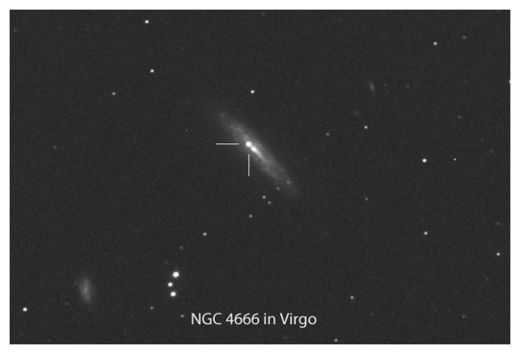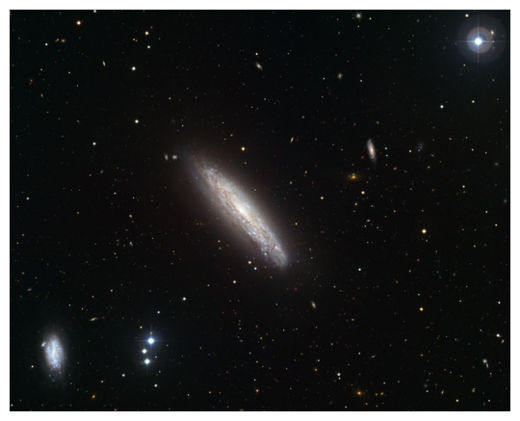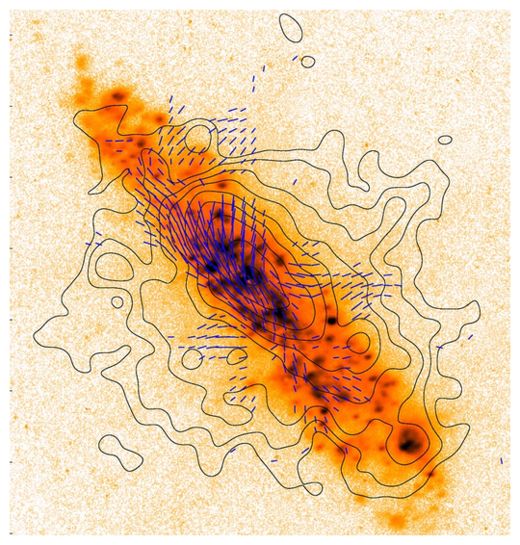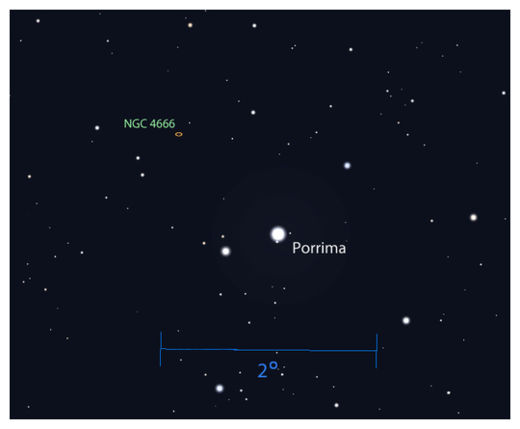Supernova in Virgo brightens

© Gregor Krannich
The bright supernova (at tick marks) in the galaxy NGC 4666 photographed on December 24, 2014. The galaxy shines at magnitude 11.8 and looks like a sliver of milky light in a telescope.
A 14th magnitude supernova discovered in the spiral galaxy NGC 4666 earlier this month has recently brightened to 11th magnitude, making it not only the second brightest supernova of the year, but an easy find in an 8-inch or larger telescope. I made a special trip into the cold this morning for a look and saw it with ease in my 10-inch (25-cm) scope at low power at magnitude 11.9.
Before the Moon taints the dawn sky, you may want to bundle up and have a look, too. The charts below will help you get there.

© ESO/J. Dietrich
NGC 4666 is also known as the Superwind Galaxy. Home to vigorous star formation, a combination of supernova explosions and strong winds from massive stars in the starburst region drives a vast outflow of gas from the galaxy into space, called a “superwind”.
With the temporary name ASASSN-14lp, this Type Ia supernova was snatched up by the catchy-titled "Assassin Project", short for Automated Sky Survey for SuperNovae (ASAS-SN) on December 9th. Only 80 million light years from Earth, NGC 4666 is a relatively nearby spiral galaxy of some notoriety.
Nicknamed the Superwind Galaxy, it's home to waves of intense star formation thought to be caused by gravitational interactions between it and its neighboring galaxies, including NGC 4668, visible in the lower left corner of the photo above.
Supernovae also play a part in powering the wind which emerges from the galaxy's central regions like pseudopods on an amoeba. X-ray and radio light show the outflows best. How fitting that a bright supernova should happen to appear at this time. Seeing one of the key players behind the superwind with our own eyes gives us a visceral feel for the nature of its home galaxy.

© M. Ehle and ESO
Hot, X-ray emitting gas in NGC 4666 billows around the main galaxy as a superwind seen here as outflows on either side of the optical image. Photo taken with the XMM-Newton telescope.

© Stellarium
“Big picture” map showing the location of the galaxy NGC 4666 in Virgo not far from Porrima. The view faces south shortly before the start of dawn in early January.
Spectra taken of ASASSN-14lp show it to be a Type Ia object involving the explosive burning of a white dwarf star in a binary system. The Earth-size dwarf packs the gravitational might of a sun-size star and pulls hydrogen gas from the nearby companion down to its surface. Slowly, the dwarf gets heavier and more massive.
When it attains a mass 1.4 times that of the sun, it can no longer support itself. The star suddenly collapses, heats to incredible temperatures and burns up explosively in a runaway fusion reaction. Bang! A supernova.

© Stellarium
Detailed map with stars to about magnitude 10. The galaxy is just a little more than a degree northeast of Porrima (Gamma Virginis).
Here are a couple maps to help you find the new object. Fortunately, it's high in the sky just before the start of dawn in the "Y" of Virgo only a degree or so from the 3rd magnitude double star Porrima, also known as Gamma Virginis. Have at it and let us know if you spot the latest superwind-maker.


0 reacties:
Post a Comment